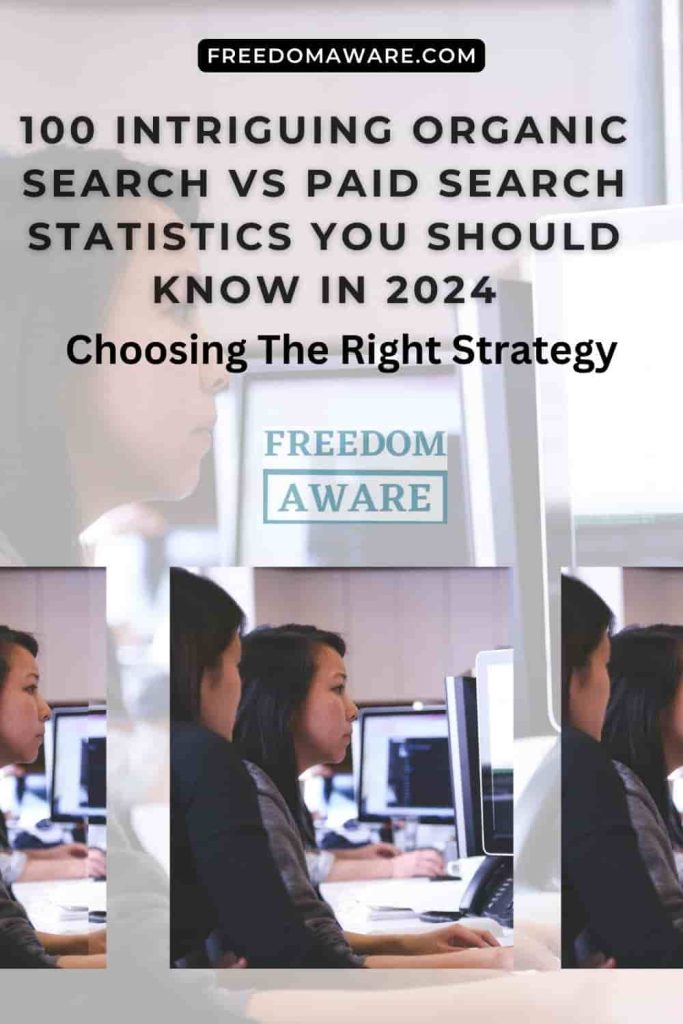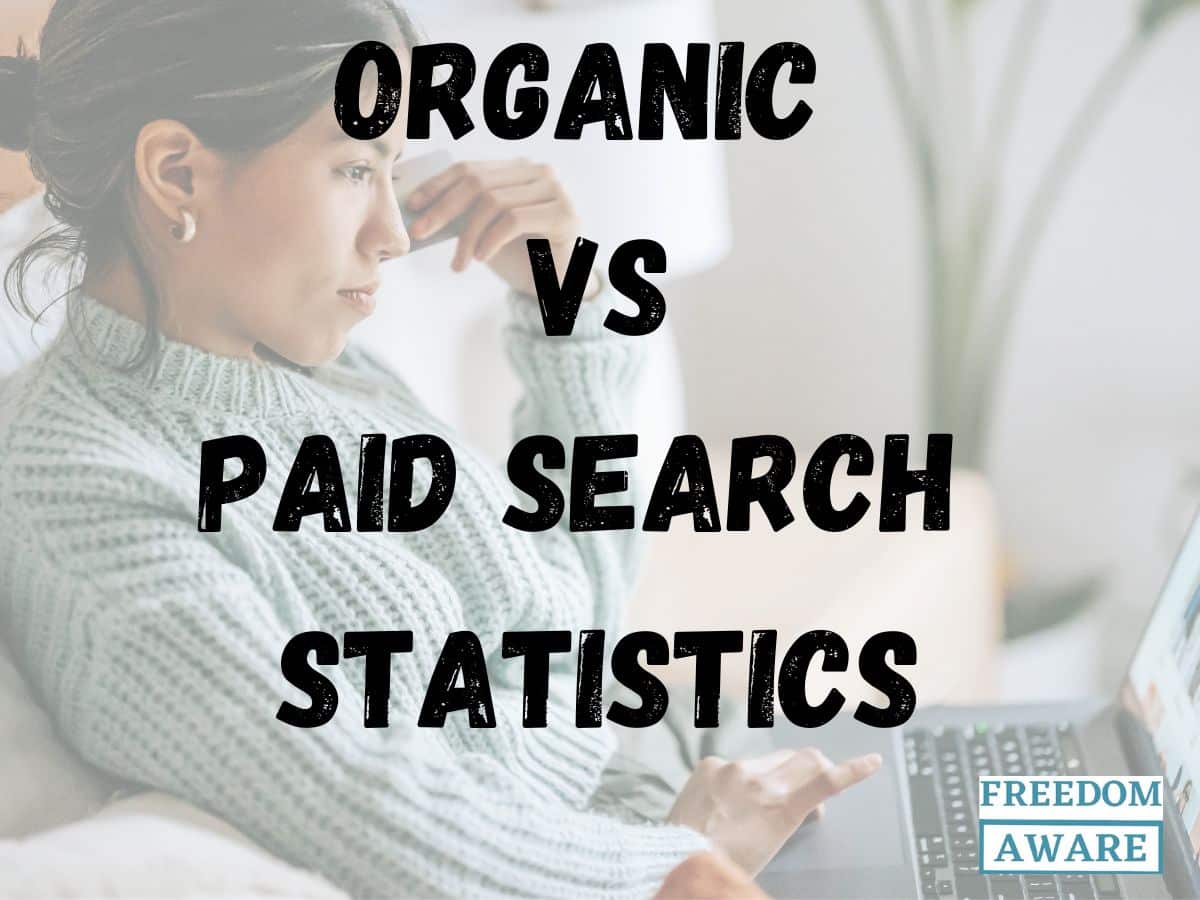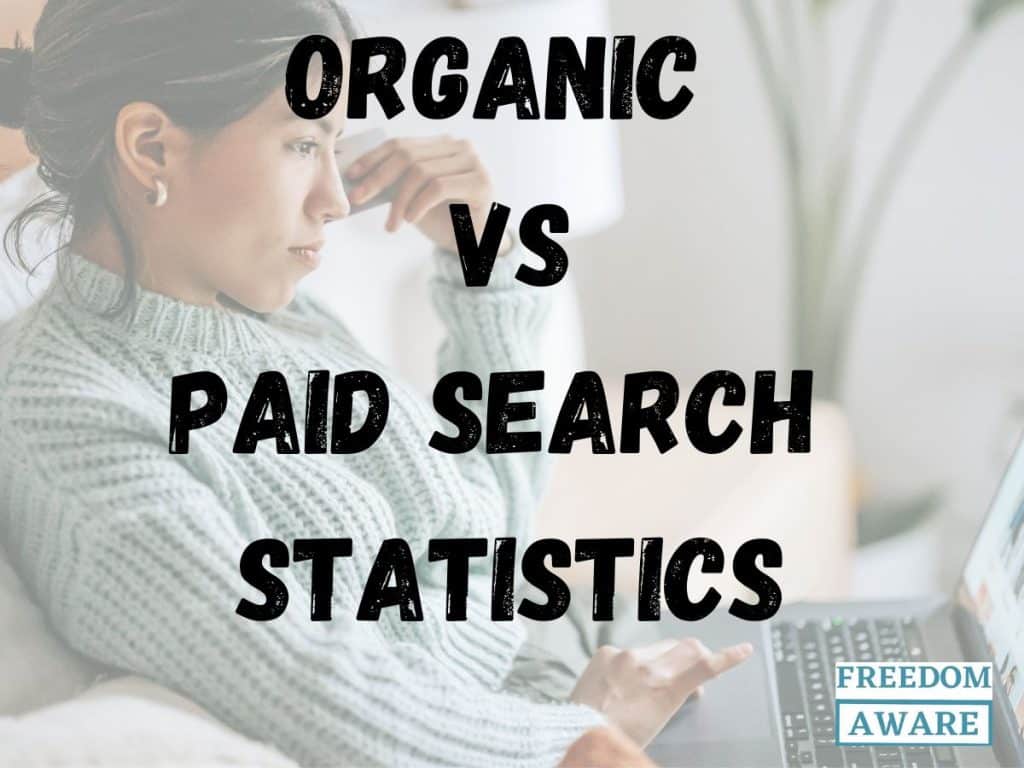
Organic Search vs. Paid Search: Choosing the Right Strategy (Organic Search vs Paid Search Statistics)
Businesses often grapple with the choice between organic and paid search for their search engine marketing (SEM) strategy. Both approaches offer advantages and drawbacks, with the optimal choice depending on your business goals, budget, and target audience.
- Organic Search: Optimizes your website and content for relevant keywords to rank higher in unpaid search results. This process requires time and effort but can be highly effective in the long run.
- Paid Search (PPC): Involves paying for ad placements on search engine results pages (SERPs). This approach delivers faster results but can be less cost-effective than organic search.
Deciding Between Organic Search and Paid Search (Organic Search vs Paid search statistics)
There’s no single “better” option between organic and paid search. Consider these factors to make an informed decision:
- Your Goals: Do you prioritize long-term brand awareness or immediate website traffic?
- Your Budget: Can you invest in ongoing SEO efforts or allocate funds for PPC campaigns?
- Your Target Audience: Understanding their search behavior can guide your keyword strategy.
Leveraging Statistics (Organic search vs Paid search statistics):
Consulting recent organic vs. paid search statistics can provide valuable insights into current trends and conversion rates. However, statistics should serve as a reference point, not a substitute for a comprehensive analysis of your specific business needs.
The Takeaway:
Both organic and paid search can be valuable tools for your online marketing strategy, driving traffic to your website. Evaluating your unique situation will help you determine the approach or a combination of both that best optimizes your online presence.
Organic Search vs. Paid Search: Key Statistics
- Organic Search (SEO) Investment: A significant portion of businesses (64%) invest in SEO techniques for organic search visibility.
- SEO Effectiveness: Three-quarters (75%) of marketers believe SEO is a valuable strategy to achieve their marketing goals.
- Organic Search Traffic: Organic search drives a substantial share (over 53%) of website traffic.
- Top Ranking Power: The top organic results on Google capture a significant portion of clicks (around 32%), with the top five results attracting nearly two-thirds (68%) of all clicks.
- Organic Search & Brand Value: Studies suggest organic search can significantly boost blog business value (by up to 429%).
- Paid Search (PPC) ROI: PPC advertising offers a return on investment (ROI) of 200%, potentially yielding $2 for every $1 spent.
- Paid Search Reach: The Google Ads display network reaches a vast audience, with an estimated 90% of global internet users.
- Combined Approach: The combination of organic and paid search can be highly effective, generating nearly 68% of website traffic (organic search: 40%, paid search: 28%).
- Benefits of Combining Strategies: Leveraging both organic and paid search can enhance brand visibility, increase click-through rates, and ultimately drive more traffic to your website.
Note: These don’t contain overly promotional claims about “double visibility” and are focused on presenting the statistics in a neutral and informative way.
Organic Search vs. Paid Search: A Traffic Showdown (Organic vs Paid Search Statistics)
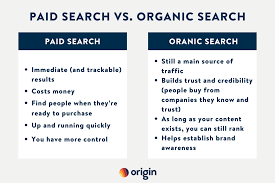
(source)
With billions of searches happening every day (over 101,000 on Google alone per second according to internetlivestats.com), businesses strive for high search engine visibility. Two main strategies achieve this: organic search and paid search.
While both aim to get your content seen by users, they take different approaches:
- Organic Search: Focuses on optimizing your website and content to rank higher in unpaid search results. This involves strategies like keyword research and content creation.
- Paid Search (PPC): Involves paying search engines to display your ads at the top of search results pages (SERPs) for relevant keywords.
Understanding Organic Search (Organic search vs Paid search statistics)
Organic search refers to the unpaid listings displayed on search engine results pages (SERPs). These results are determined by search engine algorithms that prioritize relevant and high-quality content.
- The Power of SEO: Search Engine Optimization (SEO) plays a critical role in organic search. SEO involves optimizing your website and content to rank higher for relevant keywords.
- Earning Your Place: Organic ranking takes time and effort, as search engines need to crawl and index your website content.
- Building Authority: Strong SEO practices can establish your website as an industry authority, leading to increased organic traffic in the long run.
Additional Strategies for Organic Traffic (Organic search vs Paid search statistics):
While SEO is a major player, other strategies can contribute to organic traffic generation, such as:
- Social Media Integration: Effectively promoting your website content on social media platforms can drive users to your site organically.
Note: I’ve excluded overly promotional language about “taking your SEO game seriously” and the subjective claim about social media being “not as effective” as SEO.
Understanding Paid Search (PPC) (Organic search vs Paid search statistics)
Paid search, also known as Pay-Per-Click (PPC), is an advertising strategy within Search Engine Marketing (SEM). In PPC, businesses pay search engines to display their ads at the top of search results pages (SERPs) for relevant keywords. These ads are typically labeled “Ads” to differentiate them from organic results.
- Benefits of PPC:
- Faster Results: PPC campaigns can deliver quicker results compared to organic search optimization (SEO) due to their targeted placements.
- Brand Awareness and Promotion: PPC ads are effective for promoting deals, creating brand awareness, and generating targeted traffic to your website.
- Measurable Returns: PPC allows for tracking key performance indicators (KPIs) to measure the return on investment (ROI) of your advertising efforts.
- Trade-Offs: While PPC offers faster visibility, it comes with some limitations:
- Cost: You incur ongoing costs for your PPC campaigns as long as the ads are running.
- Limited Visibility Duration: Your ad placements are only visible for the duration of your paid campaign.
Organic Search Vs. Paid Search Statistics
Organic Search: Key Statistics (Organic search vs Paid search statistics)
Organic search remains a significant player in online marketing, as evidenced by the following data:

- High Investment Rate: A substantial portion of businesses (64%) actively invest in SEO for organic search visibility (source).
- Marketeer Confidence: Three-quarters (75%) of marketers believe SEO is a valuable strategy to achieve their marketing goals (source).
- Lead Generation Power: For B2B online marketers, a significant share (57%) acknowledges SEO’s effectiveness in generating leads compared to other online marketing initiatives (source).
- Local Search Importance: A notable percentage of consumers (21%) utilize search engines daily to find local businesses near them (source).
- Google’s Dominance: As of 2020, Google captured a dominant share (92%) of organic search traffic in the United States (source).
Organic Search: Click-Through Rates and Competition (Organic Search vs Paid Search Statistics)
- Top Results Dominate Clicks: The top search results on Google capture a significant portion of clicks (around 31.7%) (source).
- with the first five results attracting nearly two-thirds (67.6%) of all clicks (source). This highlights the importance of ranking high in search results.
- First Page Holds Most Traffic: Over 95% of search traffic occurs on the first page of search engine results pages (SERPs) (source). Users are more likely to refine their search query than click through to subsequent pages.
Organic Search: Click-Through Rates and Trends (Organic search vs Paid search statistics)
- CTR Falls with Lower Ranking: Click-through rates (CTR) tend to decrease as search result positions drop on Google’s first page (source).
- The first-page result has a CTR of 28.5%, highlighting the value of ranking higher (source).
- SEO Impact on CTR: Effective SEO practices can significantly improve CTR. Studies suggest that moving to a top position can increase CTR by as much as 30.8% (source).
- Limited User Exploration: A significant portion of searchers (around 75%) don’t explore beyond the first page of results (source). This reinforces the importance of optimizing for high ranking.
- Organic Search Growth: Organic search engine visits continue to rise, with an increase from 59% to 63% observed in 2021 (source).
- The Rise of AI Search Tools: Emerging AI-powered search tools are predicted to impact the search market significantly by 2023 (source). These tools may change how users access and explore information.
- Long-Tail Keywords: Higher CTR: Long-tail keywords, which are more specific and targeted, tend to have a higher click-through rate (CTR) compared to generic keywords (source) (CTR difference: 3-5%).
- Social Media and Organic Traffic: While social media can drive traffic to your website, SEO remains a more effective strategy for organic traffic generation (source).
- Organic Search and Blog Value: Studies suggest organic search can significantly increase the business value of a blog (by up to 429%) (source).
Google Search Activity (Organic search vs Paid search statistics):
- Over 1.7 billion users access Google daily (source).
- The average user conducts 4 Google searches per day (source).
- Google’s Ranking Algorithm: Google’s search algorithm considers around 200 factors to determine the quality and relevance of websites for ranking (source). These factors include:
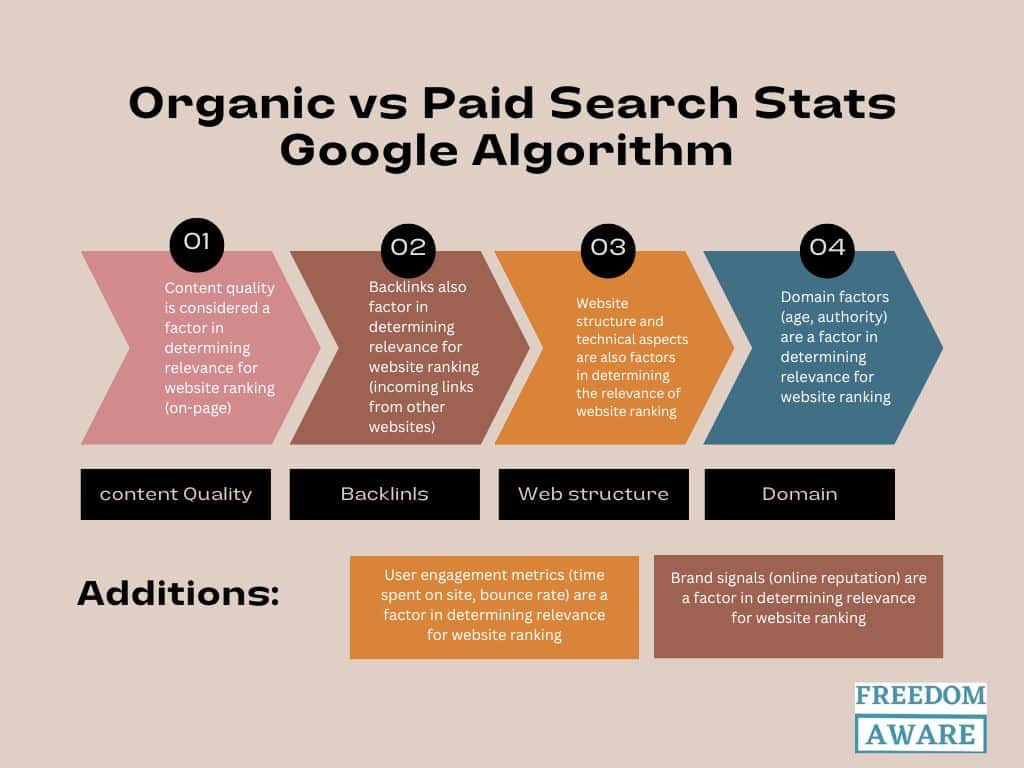
- Content quality is considered a factor in determining relevance for website ranking (on-page) (source)
- Backlinks also factor in determining relevance for website ranking (incoming links from other websites) (source)
- Website structure and technical aspects are also factors in determining the relevance of website ranking (source)
- Domain factors (age, authority) are a factor in determining relevance for website ranking (source)
- User engagement metrics (time spent on site, bounce rate) are a factor in determining relevance for website ranking (source)
- Brand signals (online reputation) are a factor in determining relevance for website ranking (source)
- Spam prevention measures are also a factor in determining relevance for website ranking (both on-site and off-site) (source)
- Organic Search: A Top Traffic Source: Organic search remains a leading source of website traffic (source).
- Mobile Shopping Growth: Over 70% of online shoppers utilize mobile devices for purchases (source). This highlights the importance of mobile-friendly website design.
- Content Length and Search Results: The average word count of content displayed on Google’s first page of results (SERP) is approximately 1890 words (source). However, content quality and relevance remain more critical factors for ranking than sheer word count.
- Search Bar Focus in Online Retail: A significant portion of online consumers (around 70%) prioritize the search bar function when navigating online retail websites (source). This emphasizes the importance of optimizing product information and searchability within your online store.
Organic search vs. Paid Search: A Statistical Comparison (Organic Search vs Paid Search Statistics)
While both organic and paid search offer benefits, marketers may consider different factors when choosing a strategy. Here’s a look at some relevant statistics:
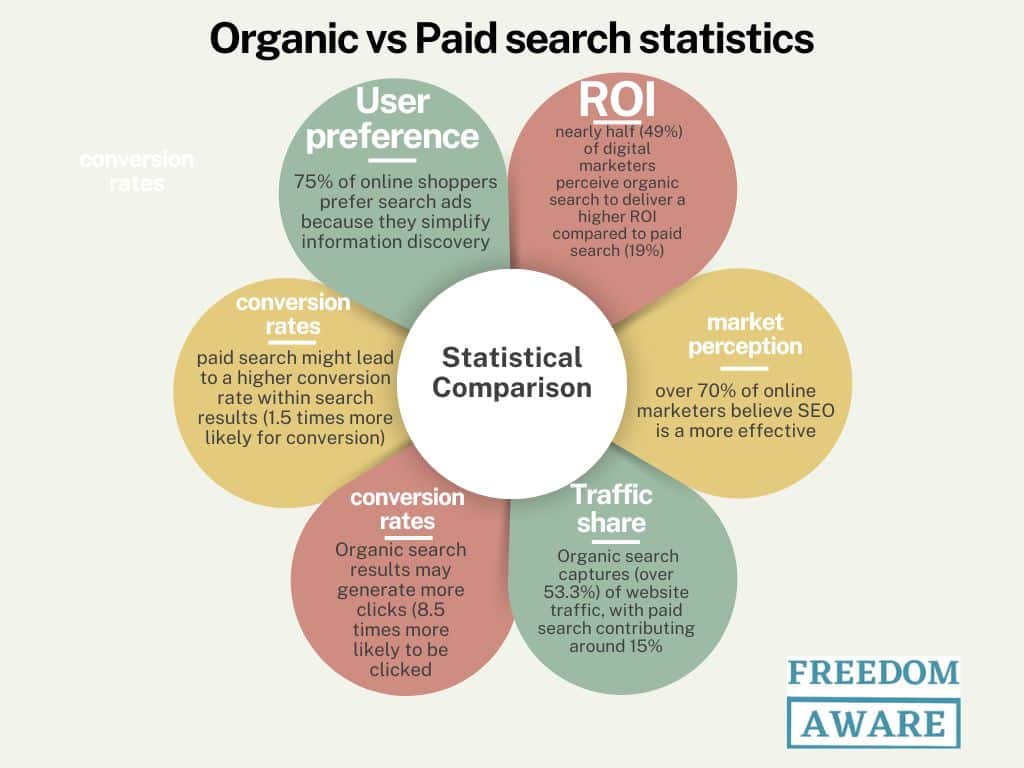
- Return on Investment (ROI): A survey suggests that nearly half (49%) of digital marketers perceive organic search to deliver a higher ROI compared to paid search (19%) (source).
- Marketer Perception: Another study indicates that over 70% of online marketers believe SEO is a more effective strategy than paid ads (source). This might be due to the long-term benefits of SEO.
- Traffic Share: Organic search captures a significant portion of website traffic (over 53.3%), with paid search contributing around 15% (source).
- Conversion Rates: Organic search results may generate more clicks (8.5 times more likely to be clicked according to one study) (source).
- However, paid search might lead to a higher conversion rate within search results (1.5 times more likely for conversion) (source).
- User Preference: A study suggests that 75% of online shoppers prefer search ads because they simplify information discovery (source).
These statistics highlight that both organic and paid search have advantages. The optimal choice depends on your marketing goals, budget, and target audience.
Paid Search User Behavior (Organic search vs Paid search statistics)
- Familiarity and Relevance: Studies suggest that over 26% of online users click on paid search ads when the ad mentions a familiar brand or directly addresses their search query (source).
- 33% of online users click on a PPC ad because it directly answers their search query (source).
- Platform Preferences: Among those clicking on paid ads, Google Ads capture the majority (63%), followed by Amazon (14%) and YouTube (9%) (source).
Paid Search Performance (Organic search vs Paid search statistics)
- Conversion Rates: Average conversion rates (actions like purchases or sign-ups) vary depending on the ad format. Search network ads tend to have a higher conversion rate (3.75%) compared to display network ads (0.77%) across various industries (source).
Paid Search Spending Trends (Organic search vs Paid search statistics)
- Growth and Investment: Search advertising spending is significant and on the rise. In 2022, it reached $185.35 billion and is projected to increase by 16% annually, reaching nearly $261 billion by 2028 (source).
- Market Reach: The Google Ads Display Network boasts a vast reach, potentially reaching around 90% of internet users globally (source).
- Increased Spending: Spending on paid search ads has seen a steady rise, from $58 billion in 2020 to $144.8 billion in 2021 (source).
- with projections of further growth to $190.5 billion by 2024 (source).
Paid Search Spending on the Rise (Organic search vs Paid search statistics)
- Overall Marketing Budget Growth: Digital marketing budgets across businesses saw a significant increase of 14% from 2020 to 2021 (source).
- US Search Ad Spending: Spending on search ads within the US market also grew, with an 8.9% increase observed in 2020 (source).
- PPC ROI: Pay-per-click (PPC) advertising offers a potential return on investment (ROI) of 200%, yielding $2 for every $1 spent (source).
- Top Paid Ad Channels: Facebook and Google Ads consistently rank among the leading paid advertising channels with high reported ROI rates (source).
- Display Ad Impact on Brand Awareness: Studies suggest that exposure to display ads can increase the likelihood of consumers researching a brand’s specific terms by 155% (source).
- Future Spending Projections: Search advertising spending in the US is expected to continue its upward trajectory, potentially reaching over $261 billion by 2028 (source).
Understanding Paid Search and SEM (Organic search vs Paid search statistics)
Choosing between organic and paid search can be challenging. However, many marketers leverage both strategies for a comprehensive search engine marketing approach.
Paid Search vs. SEM
- Paid Search (PPC): Focuses on running paid advertisements on search engines to appear at the top of results for relevant keywords.
- Search Engine Marketing (SEM): A broader strategy encompassing both organic search optimization (SEO) and paid search (PPC) to improve a website’s visibility in search results.
SEM: More Than Just Ads (Organic search vs Paid search statistics)
While SEM includes paid search advertising (PSA), it goes beyond just PPC ads. It also incorporates SEO practices to optimize a website’s content and structure for better organic ranking.
Combining Strengths (Organic search vs Paid search statistics)
By combining organic and paid search strategies, SEM offers a well-rounded approach to search engine marketing, potentially leading to increased website traffic and brand awareness.
The Power of SEM: Statistics and Benefits (Organic Search vs Paid Search Statistics)
Search Engine Marketing (SEM), which combines SEO and PPC strategies, offers significant advantages for website traffic and marketing goals. Here’s a look at some compelling statistics:
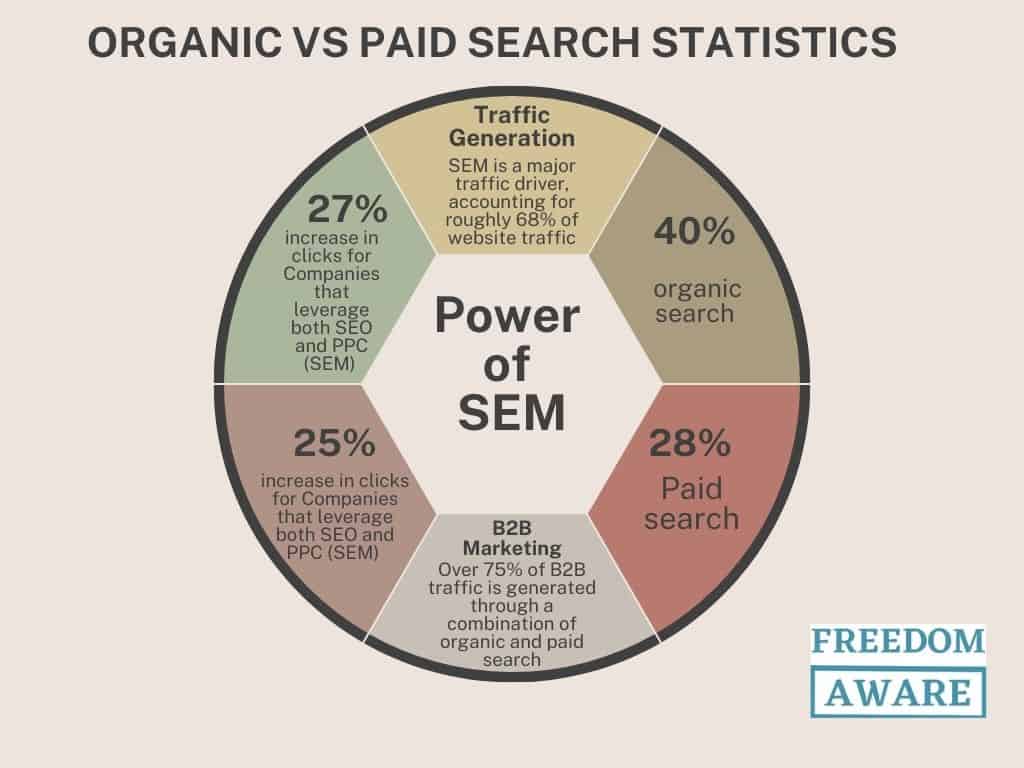
- Traffic Generation: SEM is a major traffic driver, accounting for roughly 68% of website traffic (source).
- This breaks down into 40% organic search and 28% paid search (source).
- B2B Marketing: Over 75% of B2B traffic is generated through a combination of organic and paid search (SEM) (source).
- Increased ROI: Companies that leverage both SEO and PPC (SEM) experience a 25% increase in clicks and a 27% increase in profits compared to those relying on a single strategy (source).
Why Combine SEO and PPC? (Organic search vs Paid search statistics)
- Organic vs. Paid Strengths: SEO offers long-term benefits for website ranking but requires time and ongoing effort. Conversely, PPC delivers faster results for targeted promotions and brand awareness but incurs ongoing costs (source).
- Complementary Strategies: Combining SEO and PPC creates a well-rounded SEM approach, maximizing website visibility and traffic generation (source).
Additional Search Trends (Organic search vs Paid search statistics)
- Google’s Dominance: As of February 2022, Google holds over 82.6 billion visits and remains the leading search engine (source)
- (market share: 85.5%) (source).
- Mobile Search: Mobile phone and tablet searches on Google account for approximately 90% of traffic (source).
- B2B Lead Generation: Attracting more leads is a key goal for 75% of B2B marketers, with many favoring SEM strategies (source).
- The Rise of Video Content: The popularity of video content is growing, and including it on landing pages can significantly boost search engine ranking (by up to 60% for Google’s top pages) (source).
- Visual Content Importance: Over 70% of keyword searches in 2020 included image results, highlighting the enduring value of visual content (source).
- Google’s Advertising Revenue: Google’s annual advertising revenue reached $209.49 billion in 2021, reflecting the significance of search engine marketing (source).
Mobile Search Dominates (Organic search vs Paid search statistics)
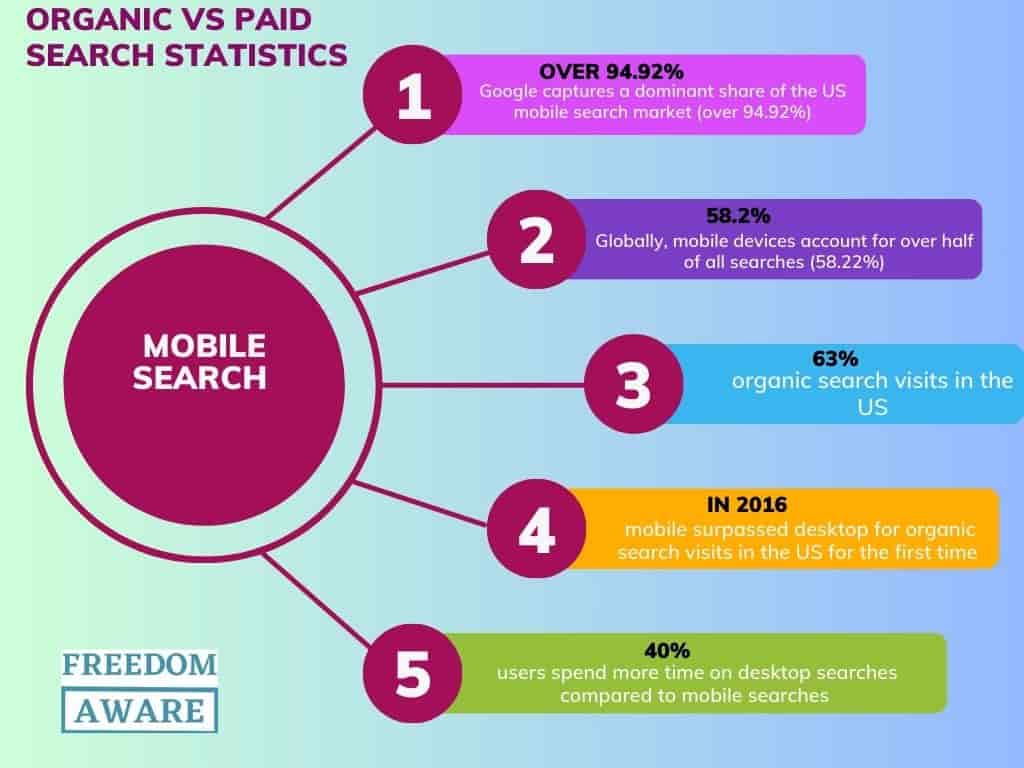
- Mobile Search Reigns Supreme: Google captures a dominant share of the US mobile search market (over 94.92%) (source).
- Mobile devices account for over half of all searches (58.22%) (source).
- Rising US Mobile Organic Search: Mobile searches now drive a significant portion of organic search visits in the US (63%) (source).
- This trend started in 2016 when mobile surpassed desktop for organic search visits in the US for the first time (source).
Optimizing for Mobile Users (Organic search vs Paid search statistics)
- Engagement Differences: On average, users spend more time on desktop searches than mobile searches (40% longer) (source).
- Prioritizing Visual Content: Mobile search results tend to display images 12.5 times more frequently and videos 3 times more often compared to desktop searches (source).
- Speed is Crucial: Mobile bounce rates (users leaving a website) increase significantly as page load times rise (32% increase from 1 to 3 seconds) (source).
Local Search on Mobile (Organic search vs Paid search statistics)
- Mobile Drives Local Action: A significant portion of mobile searches with local intent (76%) result in users visiting a nearby business within a day, and nearly a third of those visits lead to a purchase (source).
- Millennials and “Near Me” Searches: Millennials heavily utilize “near me” search features on mobile devices (92%) (source).
The Future of Mobile Shopping (Organic Search vs Paid Search Statistics)
- Mobile Web Dominance Predicted: By 2025, projections suggest that a substantial portion of internet users (72.6%) will access the web primarily through smartphones (source).
- Mobile Transactions on the Rise: Over 40% of online transactions are already conducted on mobile devices (source).
- Shopper Behavior: Mobile devices play a key role in the shopping journey. Over half of shoppers (53%) use their phones to research deals before interacting with store associates (source).
- Impact of Mobile Experience: Page load times significantly impact mobile conversions. Every additional second a page takes to load can decrease e-commerce conversions by 0.3% (source).
- User Experience Matters: A user-friendly mobile experience is crucial. Nearly 80% of people are more likely to revisit and share a mobile site if it’s easy to use (source).
- Conversely, negative mobile experiences can deter future purchases, as over 60% of users avoid brands after a frustrating mobile interaction (source).
Paid Search Trends by Industry (Organic search vs Paid search statistics)
Here’s a breakdown of key paid search statistics across various industries:
- Traffic Share: Retail & E-commerce websites capture the highest share of traffic from paid search (23.6%) (source).
- followed by B2B (12.3%) (source).
- Cost-Per-Click (CPC): The legal industry has the highest average cost-per-click ($6.75) for paid search ads (source).
- while e-commerce boasts the lowest ($1.16) (source).
- Conversion Rates: Animal & Pet businesses see the highest conversion rates (13.41%) from paid ads (source).
- while Apparel & Fashion struggle with the lowest (1.57%) (source).
- Average Cost per Conversion: Across industries, the average cost per conversion for Google search ads is $56.11 (source).
- Google Shopping Ad Budgets: The average monthly budget for Google Shopping ads varies by industry. Health & Beauty has the highest average spend ($1,815) (source).
- whereas Travel & Luggage spend the least ($273) (source).
- Cost per Conversion by Industry: The Computer & Electronics industry faces the highest cost per conversion ($101.40) for paid search (source).
- while the Auto industry enjoys the lowest ($26.17) (source).
- Understanding your industry’s average traffic share, CPC, conversion rates, and costs can help you set realistic expectations and optimize your paid search campaigns (source).
- Industries with a high cost-per-click might benefit from focusing on targeted keywords and optimizing ad copy for relevance (source).
- Industries with low conversion rates might need to improve their landing page experience or refine their ad targeting to attract more qualified leads (source).
Benefits of Paid Search (Organic search vs Paid search statistics)
Paid search (PPC) offers several advantages for businesses:
- Faster Results: Unlike SEO, which can take months to show significant improvement, PPC can deliver results quickly, making it ideal for time-sensitive promotions or new product launches (source).
- Targeted Reach: PPC allows you to target your ads to specific demographics, interests, and search queries, ensuring your message reaches a highly relevant audience (source).
- Increased Visibility: Paid search ads can appear at the top of search results, increasing brand visibility and driving more website traffic (source).
- High User Intent: People using search engines often have purchase intent, making them more receptive to targeted ads than users on other platforms (source).
- Widespread Adoption: The vast majority of marketers (96%) utilize paid search, highlighting its effectiveness as a marketing tool (source).
- Limited Availability: Many case studies are created by PPC agencies, who might be hesitant to share detailed strategies publicly (source).
- Focus on Large Brands: Published case studies often feature established companies with significant budgets (e.g., Fiat, Intel). These examples may not directly reflect the realities of small business marketing (source).
Organic vs. Paid Search: A Summary (Organic Search vs Paid Search Statistics)
Both organic search (SEO) and paid search (PPC) are valuable tools for increasing website traffic and achieving marketing goals. Here’s a quick comparison:
- Traffic Source:
- Organic Search: Generates natural traffic through website ranking in unpaid search results.
- Paid Search: Drives traffic through targeted ads displayed on search engine results pages.
- Investment:
- Organic Search: Requires ongoing effort in SEO optimization but no direct cost per click.
- Paid Search: Incurs costs associated with running ad campaigns.
- Visibility Timeline:
- Organic Search: Takes time and consistent effort to achieve high-ranking positions.
- Paid Search: Delivers faster results but only for the duration of the paid campaign.
The ideal approach often involves a combination of SEO and PPC strategies, tailored to your specific marketing goals and budget.
The Power of Combining Organic and Paid Search (Organic Search vs Paid Search Statistics)
While organic and paid search are distinct strategies, utilizing both offers significant advantages for your digital marketing plan:
- Enhanced Visibility and Brand Awareness: Paid search ads can appear at the top of search results, increasing brand exposure and driving traffic. Additionally, organic search results that rank highly contribute to long-term brand recognition (source).
- Improved Click-Through Rates (CTR): Combining paid and organic search can lead to a higher overall CTR. Paid ads can grab immediate attention, while well-optimized organic listings with strong CTAs (calls to action) can further entice users to click (source).
- Complementary Ranking Strategies: Organic search relies on factors like keyword optimization and content quality to achieve high rankings, while paid search involves bidding on keywords to secure top positions. Both approaches work together to increase your website’s visibility in search results (source).
- Data-Driven Content Creation: Paid search ad analytics provide valuable insights into user behavior and keyword performance. This data can inform your organic content creation, helping you tailor content to user intent and improve organic ranking (source).
- Targeted Audience Reach: Paid search allows for targeted advertising, ensuring your message reaches the ideal audience segment most likely to convert. While organic search aims for broader visibility, well-optimized content can also attract a relevant target audience (source).
- Campaign Optimization and Efficiency: Combining organic and paid search allows for a comprehensive marketing approach. You can leverage the strengths of each strategy to maximize your campaign reach and effectiveness, potentially leading to a higher return on investment (ROI).
Key Takeaway:
Organic and paid search are not mutually exclusive strategies; they work together to achieve robust digital marketing goals. By implementing both approaches, you can increase website traffic, brand awareness, and ultimately, conversions.
Evolving Landscape of Search Engine Marketing (SEM) in 2024 (Organic search vs Paid search statistics)
The world of SEM is constantly adapting, with new trends emerging to enhance campaign effectiveness. Here’s a look at some key areas to consider:
- Automation on the Rise: As Google limits advertiser data access, they’re introducing AI-powered tools in Google Ads to automate insights and decision-making. This trend is expected to continue, offering valuable support for marketers seeking to analyze data efficiently.
- E-commerce Heats Up: Google Shopping Ads offer a powerful tool for reaching new customers. With the rise of online shopping, these ads are expected to see increased competition. Notably, Google has made them accessible to all businesses, further intensifying the landscape.
- Beyond Google: Marketers might explore platforms beyond Google Ads as limitations are introduced. Search engines like Bing offer integration with existing Google Ads campaigns, reducing setup time. Additionally, platforms like Yahoo Advertising, Quora Advertising, and Amazon Advertising could offer alternative avenues for reaching target audiences.
- Voice Search Continues to Rise: Text searches seem to be gradually declining as users embrace voice search. This trend coincides with a shift towards long-tail and conversational keywords. Optimizing content for natural language and addressing user questions through content creation becomes increasingly important.
- AI Integration Expands: The use of AI is expected to become more widespread, impacting various aspects of SEM. Chatbots, for example, powered by AI, can enhance user experiences by answering questions and offering personalized recommendations. Additionally, AI could play a role in improving search engine ranking algorithms, emphasizing relevance and content quality.
- Mobile Optimization Takes Center Stage: With users having limited attention spans, optimizing websites for mobile devices becomes crucial. Factors like page speed, responsive design, and mobile-first indexing directly influence user experience and search engine rankings.
- Local SEO Gains Focus: Local SEO continues to be a valuable tool for businesses looking to improve search rankings within their geographical area. Providing accurate and detailed business information, including address, hours, and high-quality images, is essential. Local keyword targeting, citation building, and location-specific content also contribute to local search success.
- Personalization in Search: Search engines increasingly personalize results based on factors like user location, search history, and social media interactions. This means users might see different results for the same search query depending on these factors. Tailoring content to target the right audience remains vital for effective SEM strategies.
Concluding Note (Organic search vs Paid search statistics):
Navigating the competitive landscape of SEM requires a multi-faceted approach. Combining organic and paid search strategies, while utilizing the latest trends, can help businesses maximize their online presence and reach their target audience effectively.
